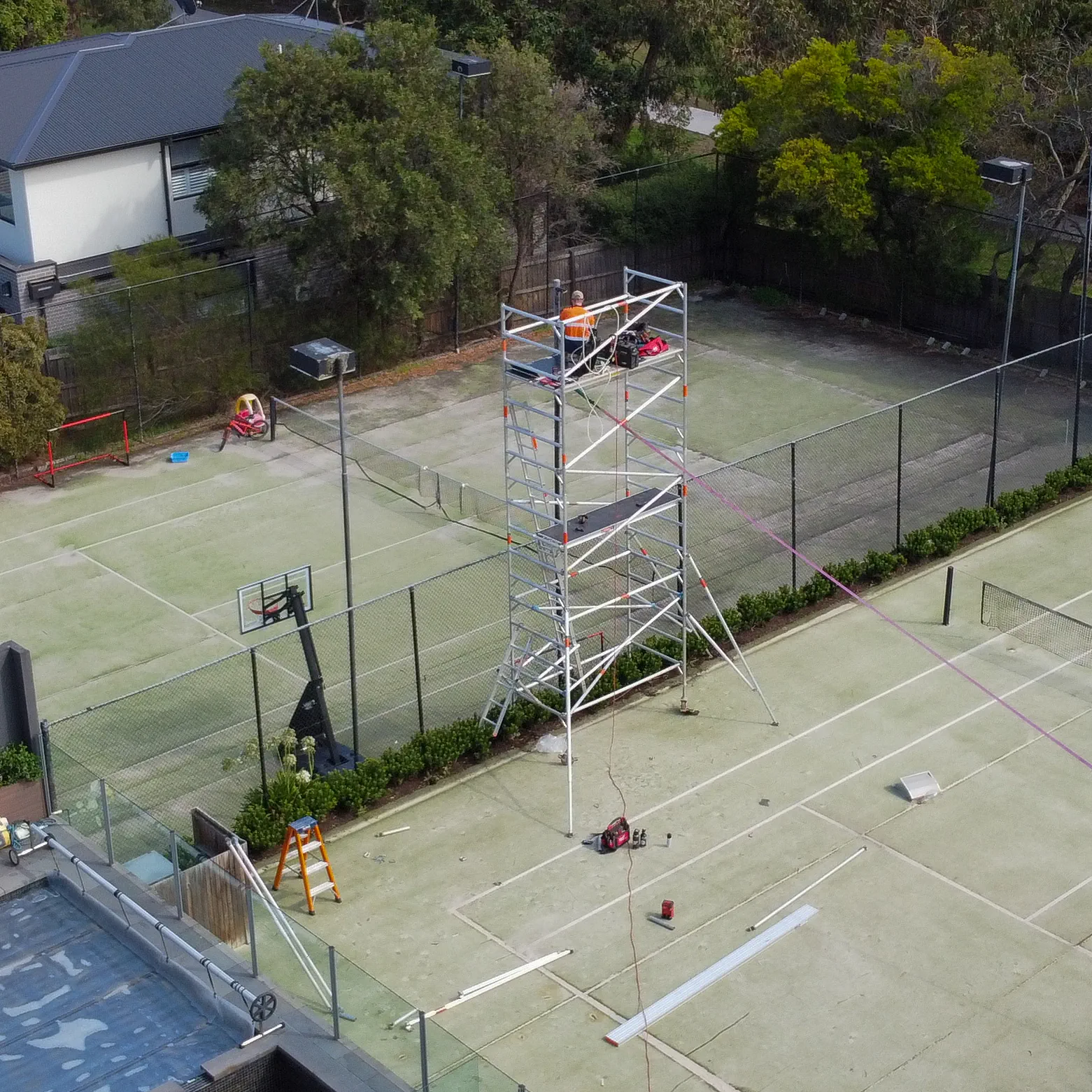Tennis Court Lighting Upgrade in Glen Iris — A Custom, Standards-Compliant LED Solution
How JPG Tech revitalised a private tennis court with engineered brackets, compliant LED fittings and AS 2560–aligned lighting performance

Quick answer: Why lighting standards matter for tennis courts
Australian Standard AS 2560.2.1 defines the brightness, uniformity and glare levels required for safe recreational tennis. Meeting this standard ensures:
- Players can see the ball clearly
- Shadows and dark patches are minimised
- Glare is controlled
- Lighting is comfortable and safe for night-time play
Modern LED sports lights are far more capable of achieving these requirements than older halogen or metal-halide systems.
Background: Dim lighting limiting evening play
Alena’s full-size court was fitted with ageing, inefficient lighting. The fittings were no longer bright enough to see the ball properly at night, and the mounting system on the poles was obsolete.
Upgrading the lighting wasn’t just cosmetic — it restored the court’s usability for evening games.
The challenge: Obsolete poles, difficult access, strict standards
1. A mounting system no modern LED fitting could attach to
The original fittings used a bracket design that no current LED sports floodlight supports.
2. No EWP access
The court was surrounded by stairs and retaining walls, preventing machinery access.
3. Height & WHS considerations
The poles stand approximately 6 metres, requiring scaffold access, fall protection and safe tool handling.
4. Standards compliance required
The lighting upgrade needed to:
- Meet AS 2560.2.1 for residential tennis courts
- Minimise light spill per AS/NZS 4282:2019
- Ensure pole loading and wind safety requirements were respected
- Use RCM-certified equipment compliant with AS/NZS 3000
Planning the installation: Safety, compliance and performance
To deliver a durable and standards-compliant upgrade, JPG Tech developed a plan that covered lighting design, mechanical safety, electrical compliance and environmental considerations.
1. AS 2560.2.1 sports lighting compliance
The selected 300W LED floodlights were chosen based on:
- Required beam angle for full-court coverage
- Achievable 250+ lux average horizontal illuminance
- Uniformity ratios suitable for recreational play
- Glare minimisation
After installation, lighting levels were checked to confirm the court met or exceeded AS 2560 recommendations.
2. Obtrusive light control (AS/NZS 4282:2019)
To prevent excessive spill onto neighbouring properties, we:
- Aligned fittings using controlled tilt angles
- Selected optics that concentrate light onto the playing surface
- Verified glare was within acceptable residential limits
This ensured good nighttime visibility on-court without disturbing the surrounding environment.
3. Mechanical and wind load safety
Before fabrication, JPG Tech assessed pole suitability for:
- The weight and wind profile of modern LED fittings
- Bracket rigidity
- Long-term structural safety under wind loads typical of suburban Melbourne
The newly fabricated brackets were welded and finished for weather resistance and securely inspected before use.
How we got it done
Once the scaffold was in place and safety measures completed, the team:
- Removed the old fittings and lowered them via a pulley system
- Cut and ground off obsolete mounting plates
- Fabricated and welded new steel brackets directly on the scaffold
- Installed the new 300W LED floodlights
- Ran new outdoor-rated cabling and made compliant, sealed connections
- Tested illumination, angles, and electrical safety devices
The result: A fully playable court after sunset
The improvement was immediate. The new LED fittings provide:
- Bright, even coverage across the entire court
- Correct uniformity ratios aligned with AS 2560
- Reduced running costs thanks to high-efficiency LEDs
- A modern, upgraded appearance
Alena’s court now feels brand new at night — and the family can play well past sunset with full visibility.
Project Snapshot
What homeowners can learn from this project
- Upgrading to modern LED sports lighting improves brightness, efficiency and gameplay quality.
- Even older courts with obsolete poles can be upgraded with custom brackets and proper engineering.
- Meeting AS 2560 ensures your court performs like a real recreational facility.
- Managing light spill maintains good relationships with neighbours.
Regular inspections and cleaning keep lighting safe and effective long-term.
FAQs
What type of lighting was installed?
JPG Tech installed RCM-certified 300W LED sports floodlights, engineered to provide the brightness, uniformity and beam spread required for recreational tennis courts.
These LEDs were specifically selected to meet AS 2560.2.1 performance recommendations.
How was glare and light spill controlled for nearby neighbours?
To meet AS/NZS 4282:2019 (Obtrusive Lighting), JPG Tech:
- Set controlled tilt angles
- Used optics that direct light onto the playing surface
- Verified that spill and glare were within acceptable residential limits
This ensures the court is bright without disturbing surrounding properties.
Why were custom brackets needed?
The existing poles used an obsolete mounting system that modern LED floodlights cannot attach to. JPG Tech fabricated, welded and finished new steel brackets on-site — directly on the scaffold — to ensure a safe, secure and durable fit.
How did the team access 6-metre poles without an EWP?
The court layout included stairs and retaining walls that prevented machinery access.
JPG Tech erected a 6m scaffold tower and used safe work-at-heights procedures, including:
- Fall-prevention measures
- Rope-and-pulley equipment handling
- Controlled grinding and welding at height
How long does an LED tennis court upgrade typically last?
High-quality LED sports lights are designed to last tens of thousands of hours, offering:
- Reduced maintenance
- Lower running costs
- Long-term uniform brightness
- Improved energy efficiency
Periodic inspections help maintain optimal performance.

%20Large.jpeg)